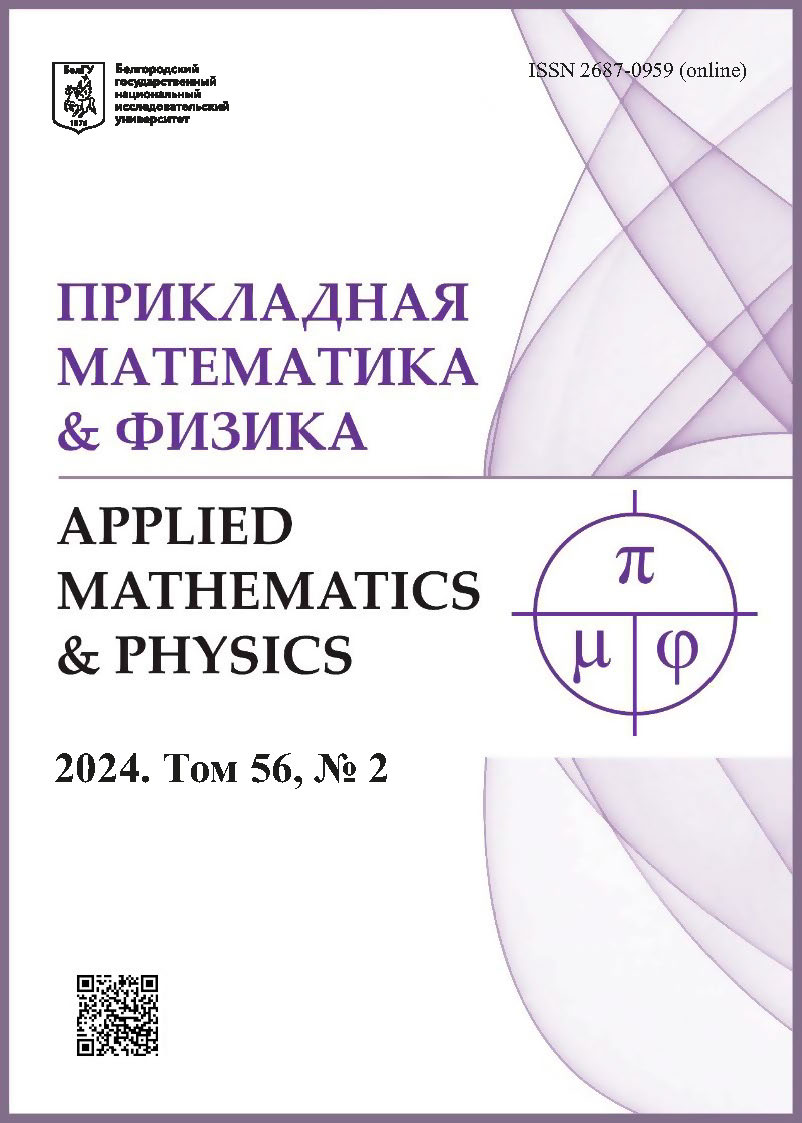Study of the Locally Nonequilibrium Process of Induction Heating of Metal in a Hydrogen Generation Reactor
DOI:
https://doi.org/10.52575/2687-0959-2024-56-2-153-162Keywords:
Methane Pyrolysis, Skin Layer, Nonlocal Heat Transfer Model, Relaxation Coefficient, Heat Source Identification, Numerical SolutionAbstract
A method is proposed for identifying the heat source that arises in the skin layer of a hydrogen generation reactor filled with liquid metal during its induction heating. Thanks to the use of the proposed method, it is possible, with a known thickness of the skin layer, to find the power of the heat source arising in it, which ensures heating of methane to a given pyrolysis temperature and the time to reach a steady state. The method is based on the use of the heat balance equation and a locally nonequilibrium mathematical model, which makes it possible to take into account the relaxation properties of materials. As a result of multivariate numerical calculations, the power of the internal heat source required for the reactor working medium (liquid metal) to reach the pyrolysis temperature was determined. The developed program makes it possible to simulate the process of induction heating of metal in a hydrogen generation reactor.
 
Acknowledgements
The work was supported by the Ministry of Science and Higher Education of the Russian Federation (theme No. FSSE-2024-0014) as part of the state task of the Samara State Technical University.
Downloads
References
–С–∞—А–∞–љ–Њ–≤ –Э.–Э. –Э–µ—В—А–∞–і–Є—Ж–Є–Њ–љ–љ—Л–µ –Є—Б—В–Њ—З–љ–Є–Ї–Є –Є –Љ–µ—В–Њ–і—Л –њ—А–µ–Њ–±—А–∞–Ј–Њ–≤–∞–љ–Є—П —Н–љ–µ—А–≥–Є–Є. –Ь.: –Ш–Ј–і–∞—В–µ–ї—М—Б–Ї–Є–є –і–Њ–Љ –Ь–≠–Ш, 2012. 383 c.
–§–Њ—А—В–Њ–≤ –Т.–Х., –Я–Њ–њ–µ–ї—М –Ю.–°. –≠–љ–µ—А–≥–µ—В–Є–Ї–∞ –≤ —Б–Њ–≤—А–µ–Љ–µ–љ–љ–Њ–Љ –Љ–Є—А–µ. –Ь.: –Ш–Ј–і–∞—В–µ–ї—М—Б–Ї–Є–є –і–Њ–Љ ¬Ђ–Ш–љ—В–µ–ї–µ–Ї—В¬ї. 2011. 168 c.
–ѓ—З–Є–Ї–Њ–≤ –Ш.–Ь., –Ь–Є—А–Њ–љ–Њ–≤–∞ –У.–Р., –Я–µ—В–Є–љ –°.–Э. –Ь–∞—В–µ–Љ–∞—В–Є—З–µ—Б–Ї–Њ–µ –Љ–Њ–і–µ–ї–Є—А–Њ–≤–∞–љ–Є–µ —В–µ–њ–ї–Њ–≤–Њ–≥–Њ —Б–Њ—Б—В–Њ—П–љ–Є—П —А–∞—Б–њ–ї–∞–≤–∞ –≤ —А–µ–∞–Ї—В–Њ—А–µ —Б –Ї–Є–њ—П—Й–Є–Љ —Б–ї–Њ–µ–Љ. –Я—А–Є–ї–Њ–ґ–µ–љ–Є–µ –Љ–∞—В–µ–Љ–∞—В–Є–Ї–Є –≤ —Н–Ї–Њ–љ–Њ–Љ–Є—З–µ—Б–Ї–Є—Е –Є —В–µ—Е–љ–Є—З–µ—Б–Ї–Є—Е –Є—Б—Б–ї–µ–і–Њ–≤–∞–љ–Є—П—Е. 2007;1:170вАУ176.
–Я–Њ–і–Њ–ї—М—Ж–µ–≤ –Р.–Ф., –Ъ—Г—З–µ—А—П–≤–∞—П –Ш.–Ь. –Ь—Г–ї—М—В–Є—Д–Є–Ј–Є—З–µ—Б–Ї–Њ–µ –Љ–Њ–і–µ–ї–Є—А–Њ–≤–∞–љ–Є–µ –њ—А–Њ—Ж–µ—Б—Б–Њ–≤ –Є–љ–і—Г–Ї—Ж–Є–Њ–љ–љ–Њ–≥–Њ –љ–∞–≥—А–µ–≤–∞ –Є –њ–ї–∞–≤–ї–µ–љ–Є—П –њ—А–Њ–≤–Њ–і—П—Й–Є—Е –Ј–∞–≥–Њ—В–Њ–≤–Њ–Ї —Б –Ї–Њ–љ—Ж–µ–љ—В—А–∞—В–Њ—А–Њ–Љ –Љ–∞–≥–љ–Є—В–љ–Њ–≥–Њ –њ–Њ—В–Њ–Ї–∞. –≠–ї–µ–Ї—В—А–Њ–љ–љ–Њ–µ –Љ–Њ–і–µ–ї–Є—А–Њ–≤–∞–љ–Є–µ. 2015;37(4):97вАУ107.
–Я–Є—Б—М–Љ–µ–љ–љ—Л–є –Р.–°., –С–∞–≥–ї–∞–є –Т.–Ь., –Я–Є—Б—М–Љ–µ–љ–љ—Л–є –Р.–Р., –†—Л–Љ–∞—А –°.–Т. –Ш–љ—В–µ–љ—Б–Є—Д–Є–Ї–∞—Ж–Є—П –њ–Њ—В–Њ–Ї–Њ–≤ —А–∞—Б–њ–ї–∞–≤–ї–µ–љ–љ–Њ–≥–Њ –Љ–µ—В–∞–ї–ї–∞ –≤ –ґ–Є–і–Ї–Њ–є –≤–∞–љ–љ–µ –њ—А–Є –Є–љ–і—Г–Ї—Ж–Є–Њ–љ–љ–Њ–Љ –љ–∞–≥—А–µ–≤–µ. –Т–∞–Ї—Г—Г–Љ–љ–Њ-–Є–љ–і—Г–Ї—Ж–Є–Њ–љ–љ–∞—П –њ–ї–∞–≤–Ї–∞. 2010;(2):34вАУ39.
–Ы—Л–Ї–Њ–≤ –Р.–Т. –Я—А–Є–Љ–µ–љ–µ–љ–Є–µ –Љ–µ—В–Њ–і–Њ–≤ —В–µ—А–Љ–Њ–і–Є–љ–∞–Љ–Є–Ї–Є –љ–µ–Њ–±—А–∞—В–Є–Љ—Л—Е –њ—А–Њ—Ж–µ—Б—Б–Њ–≤ –Ї –Є—Б—Б–ї–µ–і–Њ–≤–∞–љ–Є—О —В–µ–њ–ї–Њ- –Є –Љ–∞—Б—Б–Њ–Њ–±–Љ–µ–љ–∞. –Ш–љ–ґ–µ–љ–µ—А–љ–Њ-—Д–Є–Ј–Є—З–µ—Б–Ї–Є–є –ґ—Г—А–љ–∞–ї. 1965;9(3):287вАУ304.
–°–Њ–±–Њ–ї–µ–≤ –°.–Ы. –Ы–Њ–Ї–∞–ї—М–љ–Њ-–љ–µ—А–∞–≤–љ–Њ–≤–µ—Б–љ—Л–µ –Љ–Њ–і–µ–ї–Є –њ—А–Њ—Ж–µ—Б—Б–Њ–≤ –њ–µ—А–µ–љ–Њ—Б–∞. –£—Б–њ–µ—Е–Є —Д–Є–Ј–Є—З–µ—Б–Ї–Є—Е –љ–∞—Г–Ї. 1997;167(10):1096вАУ1106.
–Ц–Њ—Г –Ф., –Ъ–∞—Б–∞—БвАУ–С–∞—Б–Ї–µ—Б X., –Ы–µ–±–Њ–љ –Ф–ґ. –†–∞—Б—И–Є—А–µ–љ–љ–∞—П –љ–µ–Њ–±—А–∞—В–Є–Љ–∞—П —В–µ—А–Љ–Њ–і–Є–љ–∞–Љ–Є–Ї–∞. –Ь–Њ—Б–Ї–≤–∞ вАУ –Ш–ґ–µ–≤—Б–Ї: –Э–Ш–¶ ¬Ђ–†–µ–≥—Г–ї—П—А–љ–∞—П –Є —Е–∞–Њ—В–Є—З–µ—Б–Ї–∞—П –і–Є–љ–∞–Љ–Є–Ї–∞¬ї –Ш–љ—Б—В–Є—В—Г—В –Ї–Њ–Љ–њ—М—О—В–µ—А–љ—Л—Е –Є—Б—Б–ї–µ–і–Њ–≤–∞–љ–Є–є, 2006.
–°–Њ–±–Њ–ї–µ–≤ –°.–Ы. –Я—А–Њ—Ж–µ—Б—Б—Л –њ–µ—А–µ–љ–Њ—Б–∞ –Є –±–µ–≥—Г—Й–Є–µ –≤–Њ–ї–љ—Л –≤ –ї–Њ–Ї–∞–ї—М–љ–Њ-–љ–µ—А–∞–≤–љ–Њ–≤–µ—Б–љ—Л—Е —Б–Є—Б—В–µ–Љ–∞—Е. –£—Б–њ–µ—Е–Є —Д–Є–Ј–Є—З–µ—Б–Ї–Є—Е –љ–∞—Г–Ї. 1991;161(3):5вАУ29.
–Ы—Л–Ї–Њ–≤ –Р.–Т. –Ґ–µ–Њ—А–Є—П —В–µ–њ–ї–Њ–њ—А–Њ–≤–Њ–і–љ–Њ—Б—В–Є.1967. –Ь.: –Т—Л—Б—И–∞—П —И–Ї–Њ–ї–∞. 600 —Б.
–Т–ї–∞—Б–Њ–≤ –Т.–Т., –†–∞—Г—В–Є–∞–љ –Э.–Р. –Ъ–Њ—А—А–µ–Ї—В–љ–∞—П —А–∞–Ј—А–µ—И–Є–Љ–Њ—Б—В—М –Є —Б–њ–µ–Ї—В—А–∞–ї—М–љ—Л–µ –∞–љ–∞–ї–Є–Ј –∞–±—Б—В—А–∞–Ї—В–љ—Л—Е –≥–Є–њ–µ—А–±–Њ–ї–Є—З–µ—Б–Ї–Є—Е –Є–љ—В–µ–≥—А–Њ–і–Є—Д—Д–µ—А–µ–љ—Ж–Є–∞–ї—М–љ—Л—Е —Г—А–∞–≤–љ–µ–љ–Є–є. –Ґ—А—Г–і—Л —Б–µ–Љ–Є–љ–∞—А–∞ –Є–Љ. –Ш.–У. –Я–µ—В—А–Њ–≤—Б–Ї–Њ–≥–Њ. 2011;(28):75вАУ113.
Rossikhin Yu.A., Shitikov V.V. The hyperbolic model with a small parameter for studying the process of impact of a thermoelastic rod against a heated rigid barrier. Applied Mathematical Sciences. 2016;10(41):2037вАУ2050.
–Ъ–∞–ї–Є—В–Ї–Є–љ –Э.–Э. –І–Є—Б–ї–µ–љ–љ—Л–µ –Љ–µ—В–Њ–і—Л. –Ь.: –Э–∞—Г–Ї–∞, 1978.
Ghazanfarian J., Shomali Z., Abbassi A. Macro- to nanoscale heat and mass transfer: the lagging behavior. International Journal of Thermophysics. 2015;36:1416вАУ1467.
Abstract views: 188
##submission.share##
Published
How to Cite
Issue
Section
Copyright (c) 2024 Applied Mathematics & Physics

This work is licensed under a Creative Commons Attribution 4.0 International License.





